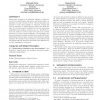Free Online Productivity Tools
i2Speak
i2Symbol
i2OCR
iTex2Img
iWeb2Print
iWeb2Shot
i2Type
iPdf2Split
iPdf2Merge
i2Bopomofo
i2Arabic
i2Style
i2Image
i2PDF
iLatex2Rtf
Sci2ools
MHCI
2007
Springer
2007
Springer
Sensing-based interaction for information navigation on handheld displays
Information navigation on handheld displays is characterized by the small display dimensions and limited input capabilities of today’s mobile devices. Special strategies are required to help users navigate to off-screen content and develop awareness of spatial layouts despite the small display. On the other hand, handheld devices offer interaction possibilities that desktop computers do not. Handheld devices can easily be moved in space and used as a movable window into a large virtual workspace. We investigate different information navigation methods for small-scale handheld displays using a range of sensor technologies for spatial . We compare user performance in an abstract map navigation task and discuss the tradeoffs of the different sensor and visualization techniques. Categories and Subject Descriptors H.5.2 [Information Interfaces and Presentation]: User Interfaces—input devices and strategies, interaction styles, evaluation/methodology General Terms Design, Experiment...
Handheld Devices | Human Computer Interaction | MHCI 2007 | Mobile Devices | Small-scale Handheld Displays |
| Added | 08 Jun 2010 |
| Updated | 08 Jun 2010 |
| Type | Conference |
| Year | 2007 |
| Where | MHCI |
| Authors | Michael Rohs, Georg Essl |
Comments (0)

